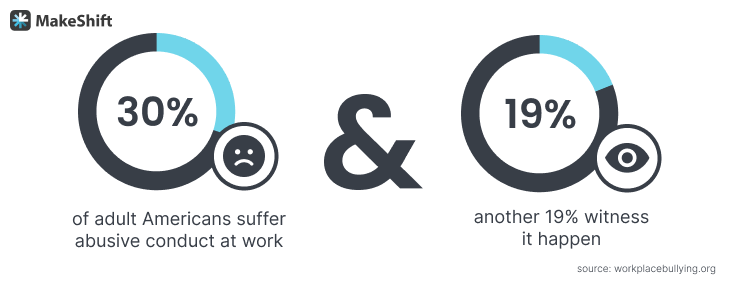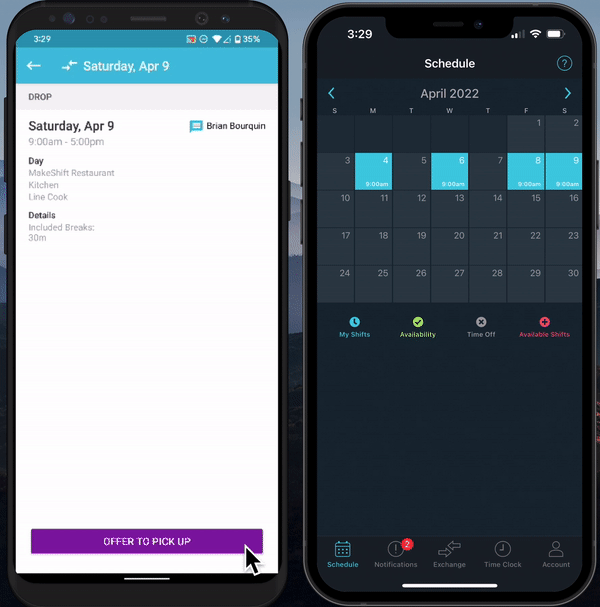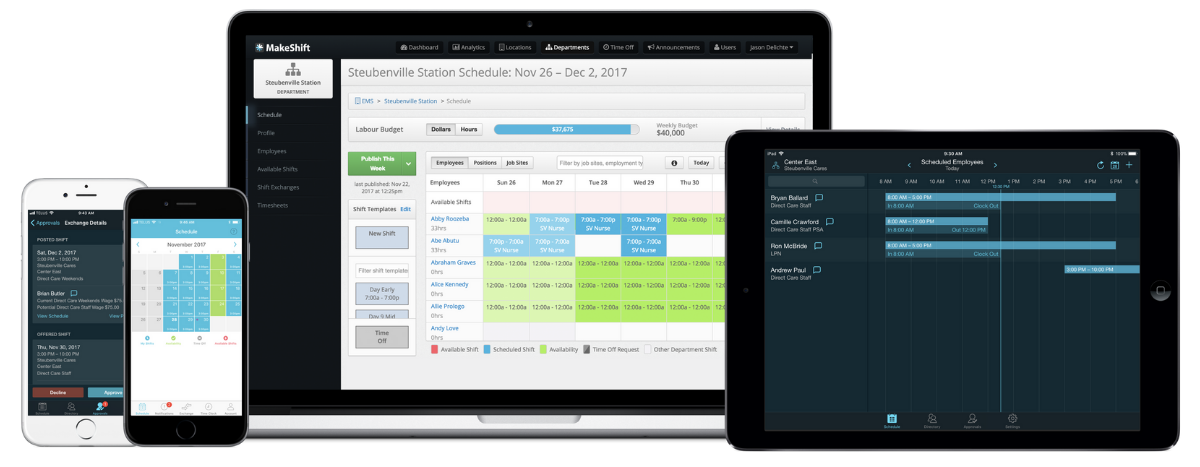Your employees are the backbone of your company and are essential for stability and growth. Without them, your business wouldn’t be able to handle day-to-day operations.
If your company suffers from employee absenteeism, you may have realized the adverse effects already. Unscheduled absences affect the work environment, your company’s finances, and much more.
Although you can expect a couple of unplanned absences, chronic employee absenteeism needs to be properly addressed.
At MakeShift, we are proponents and practitioners of a people-first approach. But, before we in dive into how your business can effectively reduce employee absenteeism, let’s take a step back and look at some of its adverse effects.
In this article, you’ll learn:
- What is Employee Absenteeism?
- What are the Causes of Employee Absenteeism?
- What is the Cost of Employee Absenteeism?
- How to Deal with Your Employees Skipping Work.
- How to Deal with an Employee Who is Always Absent.
- What is Considered Excessive Employee Absenteeism?
- Can I Terminate an Employee for Excessive Absenteeism?
- Eliminate Your Employee Absenteeism with MakeShift.
What is Employee Absenteeism?
Employee absenteeism is when employees frequently take unplanned and unannounced absences.These absences don’t include paid time off (PTO) or authorized leaves such as vacation days, sick days, or paternal leave.
In other words, employee absenteeism is defined as an illegitimate absence that the employer doesn’t excuse.
While unplanned absences include personal or family emergencies that can’t be prevented, excessive employee absenteeism drastically impacts every company.
Types of Absenteeism
There are three types of absenteeism:
- Planned and approved
- Unplanned and approved
- Unplanned and unapproved
Understanding each type of absenteeism helps define when employee absenteeism starts to become a problem in your company.
Let’s discuss a few examples from each.
1. Planned and Approved Absences
Planned and approved absences are situations when the employee has already planned to take time off and has it approved by your company.
Examples include:
- Holiday traveling and vacations
- Maternity or paternity leave
- Doctor’s appointments
2. Unplanned and Approved Absences
This type of absenteeism is unforeseen by the employee but gets approved due to the circumstances.
Examples include:
- Sick leave or medical emergency
- Bereavement
- Accidents
3. Unplanned and Unapproved Absences
Unplanned and unapproved absences, also known as unauthorized absences, are out of the employer’s control.
Examples include:
- Personal reasons
- Disengagement
- Stress
- Burnout
What Are the Causes of Employee Absenteeism?
In general, there are two different causes of employee absenteeism: Technical causes or psychological and physical causes.
The majority of employee absenteeism falls under these two categories.
Technical Causes of Absenteeism
The technical causes of employee absenteeism are typically the easiest to address. Here are a few examples:
Commuting Issues
Employees can often miss hours of work due to long commutes. A long commute can be caused by delayed public transportation, car problems, road accidents, and waking up late.
Scheduling Issues
If an employee schedules an absence but the request gets lost in translation, then your company has prevalent scheduling issues. For example, your HR scheduler may miss the email requesting the absence.
Lack of Scheduling Software
A manual scheduling system through emails or written forms can cause a logistical nightmare within your company. This leads to lost absence requests and the employee being unsure if their absence was approved. Using a people-first employee scheduling software, like MakeShift, can address this issue.
Miscommunication
Miscommunication is caused by poor communication about availability and a lack of employees understanding absence policies.
Psychological and Physical Causes of Absenteeism
Psychological and physical causes of absenteeism are more challenging to address because the employee may not share the exact reasoning for their absence.
Let’s discuss a few examples:
Workplace Harassment or Bullying
A 2021 workplace bullying survey found that 30% of adult Americans suffer abusive conduct at work, and another 19% witness it happen. Since workplace harassment affects 49% of U.S. adult workers, it’s easy to understand how this can lead to employee absenteeism.

Examples of workplace bullying include unfair treatment, spreading rumors, undermining someone, sexual harassment, and unethically denying someone promotional opportunities.
Mental Health Issues
There are over 1 million workers estimated to be absent every day because of stress. Stress is caused by many reasons and is the leading cause of employee absenteeism.
Furthermore, burnout is a major contributor to employee absenteeism. Especially in the healthcare industry, long hours and stressful work lead to burnout and employee absenteeism. This is commonly seen in senior care living centers and private clinics where the employees are under significant pressure.
Family Troubles
It can be difficult for employees to leave their family troubles out of the workplace. Difficult family situations cause employees to often take unplanned and unexcused absences. Two examples include divorce circumstances and a lack of childcare support.
Team and Management Issues
This can occur when an employee doesn’t agree with or respect decisions made by their management team. As a result, the employee can become bitter, disengaged, and lack the motivation to go to work.
Major and Minor Illness
Illnesses are a legitimate excuse to skip work. However, if this happens too often, the employee may not be suited to work at a company until their health issues are solved.
What Is the Cost of Employee Absenteeism?
The cost of employee absenteeism goes further than only financial damage and lack of productivity.
These underestimated employee absenteeism costs are indirect costs, while the predictable costs are direct costs.
Direct Costs of Absenteeism
Direct costs of employee absenteeism are more straightforward to quantify than indirect costs.
Wages Associated with Unreported PTO
According to a study from Circadian on absenteeism and its effect on wages, unscheduled absences cost around $2,660 each year for salaried employees and $3,600 per year for each hourly worker.
High Cost of Replacement Workers
When unexcused absences occur, you may need to quickly fill that shift or worse hire temporary workers, which adds an additional financial burden to your company.
Overtime Pay for Employees Picking Up the Slack
Since the absent employees can’t conduct their work, employees who do show up may need to work overtime to cover the absent employees.
Administrative Costs of Managing Absenteeism
Employee absenteeism also causes your scheduling team to spend funds and time restructuring employee assignments and finding additional help. Your managers may also spend excessive time dealing with disciplinary tasks.
Indirect Costs of Absenteeism
Although the significance of direct costs is high, indirect costs represent the larger impact of employee absenteeism.
Low Company Morale
Employee absenteeism causes poor morale among the employees who have to complete additional work to cover for their absent coworkers.
Reduced Productivity
Low company morale also causes reduced productivity as your employees are unhappy with extra work.
Poor Quality of Products or Services Due to Understaffing
When your company is understaffed, it may lead to poor quality products or services because employees will try to rush to complete the job. Furthermore, employees may not have the required skillsets to conduct certain on-the-job activities.
Safety Issues
A lack of present employees can also cause safety issues when inadequately trained employees fill in for others.
High Turnover
Employee absenteeism also leads to high turnover as you may need to release and hire new employees.
Calculating the Costs of Absenteeism
The exact cost of employee absenteeism is difficult to calculate because of the different costs discussed in the previous section.
If you need a rough estimate of what employee absenteeism is costing your company, you can multiply the employee's daily wage by two for each absence. This will give you a ballpark approximation of an employee's absenteeism cost.
How To Deal With Your Employees Skipping Work
There are dozens of methods businesses use to prevent employee absenteeism as well as reduce it.
Although you can never eliminate employee absenteeism completely, let’s discuss seven strategies you can use to dramatically reduce it from happening.

1. Take a People-First Approach
Your employees are the heart of your company and should be treated as such. This is why taking a people-first approach is the best way to reduce employee absenteeism.
A people-first approach is a company culture that’s highly focused on employee well-being. Your employees should have a say in their schedules. They should also play a role in what type of jobs they are given to best utilize their skillsets.
MakeShift is a people-first solution and company. Our software enables employee involvement by letting employees enter their preferred availability.
In essence, MakeShift allows you to create schedules around employee availability, projected company budgets, and an optimal schedule template.
Best of all, MakeShift is cloud-based and always accessible. You can also broadcast available shifts to your team to quickly fill gaps in the schedule.
In addition, the software lets you add fatigue management rules to avoid burnout situations due to the day-to-day schedule of each employee. An example of a fatigue management rule is a warning notification window that states an employee will be working more than eight hours on a particular day if assigned an additional shift.
.gif?width=2880&name=Fatigue%20Management%20(1).gif)
With real-time fatigue management, you never have to worry about overscheduling employees and causing them to burn out.
2. Simplify Absence Requests and Approvals
You can deal with employee absenteeism by simplifying your absence requests and approvals process. However, if your current system is complex, time-consuming, or outdated, it’s time to abandon it.
The majority of modern companies have ineffective callout systems. Typically, if someone drops a shift at the last minute, the scheduler needs to bring out the Rolodex to find somebody to cover the shift.
They’ll need to call each potential replacement individually until they find somebody who can fill in the gap.
For this reason, you need scheduling tracking software that simplifies absence requests and approvals. Employees shouldn’t need to jump through hoops and ladders to request time off, especially when they have a legitimate reason.
MakeShift solves this problem as well as many other causes of employee absenteeism. MakeShift is an innovative scheduling tracking software that makes it easy to request absences and for HR managers to approve them.
MakeShift allows for custom Time Off types to be created for the employee to request. This customization creates an opportunity for additional time off requests such as Designated Days Off, Leave of Absence, Parental Leave, or Mental Health Day.
Our MakeShift mobile app allows employees to directly request time-off from their smartphones.
No more emails, handwritten letters, or other ineffective forms of absence request communication.
MakeShift also uses an innovative callout system that can send an available shift notification to eligible employees with specified skills tags, while also taking into account their preferred Availability. The callout system makes it simple to find a replacement with the required skill set to complete the work needed for that shift
Once the HR scheduler receives a request or determines the most suitable replacement, the scheduler can use the mobile app to notify the employee that they’ve been approved to work.

Rather than calling everyone, you can use MakeShift to see who’s available. This reduces the time spent going back and forth with potential replacements and all the friction that comes along with it.
MakeShift also reduces fatigue among managers and schedulers to create an efficient and comprehensive work environment.
3. Effectively Tracking Absenteeism
Another way to reduce employee absenteeism is to accurately track it in the first place. This means keeping track of how many hours and days each employee has skipped. With this information, you can see who’s chronically absent.
With MakeShift’s mobile app, employees can clock in and out directly on their smartphones.
This feature includes geofence tracking and photo punches to prevent buddy punching.
With accurate timesheets, you can quickly approve timesheets and see who is working and who isn’t.
4. Create an Employee Attendance System and Policy
It’s critical that your company has an employee attendance system and policy that’s clearly visible and shown to each employee.
An official attendance policy provides clear expectations for work behavior among your team. This policy should be fair and announced to everyone in your organization.
Your official employee attendance policy will explain how to request time-off and what qualifies as an excusable absence.
Remember, your number one priority is to build a people-first culture, and creating a fair attendance policy is part of the process.
5. Address Unscheduled Absences Immediately
When unscheduled absences occur, it’s essential to address them as soon as possible. However, your immediate action shouldn’t be to punish the employee who skipped work. Instead, your goal should be to understand why they were absent and how you can help prevent it in the future.
As you know, absences are caused by dozens of reasons, and you never know what an employee is going through. Punishment can worsen employee morale and cause even more unexcused absences in the future.
Furthermore, you should re-teach the employee how to request absences. There’s a chance the employee wanted to make an absence request but didn’t know how. With MakeShift, employees can request time-off directly on the web or mobile app.
6. Reward Good Behavior in the Workplace
As a people-first company, you should build team morale by rewarding good behavior. In fact, companies with recognition programs that improve employee engagement have 31% lower voluntary turnover.

Furthermore, it may be surprising for you to learn that training and development is one of the best ways to improve employee morale. Employees want to learn new skills and grow to become a leader in the company.
In addition to training opportunities, you can enhance company morale by encouraging greater collaboration and engagement among teams and departments. Employees want their opinions heard, and they should take part in company discussions.
7. Discover and Treat the Root Cause of Absenteeism
Instead of only talking to employees once they have unexcused absences, it’s essential to check in with your team members regularly.
Your employees’ mental health should be a significant priority for your company. This involves direct conversations between an employee and their manager or HR representative. The conversation should be rooted in honesty. Managers should show that they care about the well-being of the employee.
How to Deal with an Employee Who is Always Absent?
Whether or not the absence was excused or unexcused, employees usually have a legitimate reason for skipping work. You should hold a meeting with the employee who is always absent and find out what’s causing this to happen.
The conversation should be driven with a respectful and empathetic attitude because you never know what’s causing the absences.
Once you find out the reason, you can begin building a solution.
Try to be as accommodating as possible but don’t be afraid to take disciplinary action if the employee’s behavior doesn’t change in the future.
What is Considered Excessive Employee Absenteeism?
There isn’t a set and defined rule to describe excessive employee absenteeism. It depends on your own business and what you believe falls under excessive employee absenteeism.
Can I Terminate an Employee for Excessive Absenteeism?
If the employee doesn’t have a legitimate reason for their excessive absenteeism and you have an absenteeism policy they're breaking, it’s perfectly acceptable to terminate the employee.
However, it’s essential to take a people-first approach and try to solve the excessive absenteeism before taking severe disciplinary action.
Eliminate Your Employee Absenteeism Rate with MakeShift
Your company’s goal should be to create a culture that supports and empowers employees, so they don’t feel the need to be absent. If the company does have an emergency that causes an absence, it should be easy for them to quickly request the leave.
MakeShift facilitates a smooth and seamless request and approval process to keep your business humming. With MakeShift, employees can enter their preferred availability to reduce employee absenteeism. This allows you to assign shifts based on employee availability and prevent overscheduling.
MakeShift also provides a shift exchange feature where employees can essentially swap shifts or put their shift up for a drop so that other employees can offer to work it for them instead of taking an absence.
Employee absenteeism is a major problem for many businesses, from small local businesses to giant international conglomerates.
However, one thing is true for every company. The employees are the most important part of the business.
For this reason, you should give your employees the proper tools they need to request time off and make their own schedules.
By reducing employee absenteeism with MakeShift, you can significantly improve your company’s bottom line and morale.
Start your 14-day free trial of MakeShift today to see how our software can lower your employee absenteeism.




